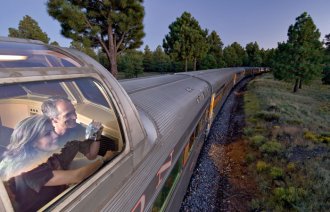

Schedule & Route
It’s your time to take a legendary journey to an extraordinary place! The Grand Canyon Railway departs daily at 9:30 a.m. from Williams, Arizona, which is about 30 miles west of Flagstaff, just off Interstate 40. The train travels almost due north to the South Rim of Grand Canyon National Park, arriving at 11:45 a.m. The trip measures 65 miles and takes 2 hours and 15 minutes each way—45 minutes faster than in 1901 when the train made its first trip. The train departs Grand Canyon Depot at 3:30 p.m., returning to the Williams Depot at 5:45 p.m. During peak demand periods a second train departure that departs at 10:30 a.m. will be added. Both departures will have the same amount of time to enjoy and explore Grand Canyon. All aboard!
THE REGION
Grand Canyon Country is located on the Colorado Plateau in northern Arizona. Most of the plateau is set at an elevation of 5, 000 feet. However, the plateau also includes Williams and the Grand Canyon, both at about an elevation of 7, 000 feet, and the San Francisco Peaks, the highest point in Arizona at over 12, 600 feet. As a result, the journey through Grand Canyon Country features a variety of stunningly different landscapes: from the Ponderosa pine forest surrounding Williams, to a gentle drop in elevation down to the wide-open prairie before climbing back up to the Pinion pine forests as the Train approaches Grand Canyon National Park.
NATIVE PEOPLES
Many Native American reservations are in and around Grand Canyon National Park and Northern Arizona. This includes the Navajo, Hopi, Havasupai and Paiute. Their culture and way of life have made an indelible impression on the region. Designers like Mary E.J. Colter, who is responsible for many of the structures built on the South Rim, drew upon the inspiration of the surrounding native cultures.
DIVERSE CLIMATE
The Colorado Plateau is semi-arid and water can be scarce. However, communities like Williams and Flagstaff typically see snowy winters, and the snowmelt provides the region with its water base. The late summer months usually see monsoon rains, which occur almost daily, typically in the afternoon. When visiting the area, the best advice is to dress in layers.
WILDLIFE
As you travel through the forests of Grand Canyon Country, keep your eyes out for elk, mountain lions, mule deer, squirrels, and even skunks. In the high desert, it’s common to see pronghorn, which look like antelope, as well as a variety of birds—from bald eagles to horned owls, ravens to California condors. While at the South Rim, you’ll notice the animals are accustomed to humans, but please don’t feed the animals as this increases their dependency on people for food.
PLANTS
Along the way, you’ll see a variety of plants and trees as you change in elevation. In the first part of the trip leaving Williams and as you approach the Grand Canyon, you’ll be at over 6, 000 feet elevation, where you’ll be surrounded by forests of Ponderosa pine, Douglas fir, spruce and aspen. In the middle part of the journey, in the Upper Sonoran Zone, you’ll see Pinyon-Juniper woodlands, sagebrush, grama grass, and a variety of brush like live oak, salt bush and mountain ash.
RELATED VIDEO












